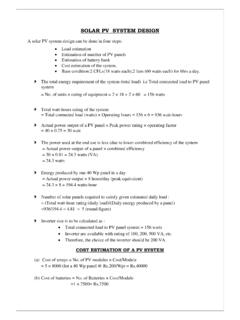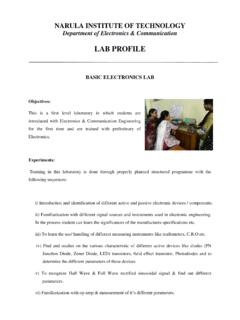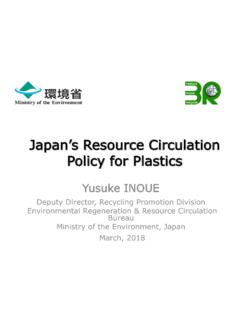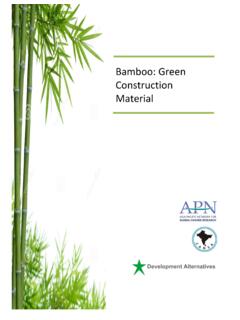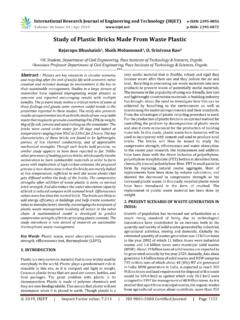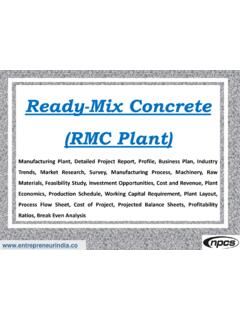Transcription of Draft Project Proposal on Rainwater Harvesting at NIT Campus
1 Narula Institute of Technology / Civil Engineering Dept / Agarpara1 Draft Project Proposal on Rainwater Harvesting atNIT CampusByThe Civil Engineering DepartmentNarula Institute of TechnologyNarula Institute of Technology / Civil Engineering Dept / Agarpara2 ContentPreamblePage 3 Chap I:IntroductionPage 6 Chap II:Objective of Project ProposalPage 7 Chap III:Need for Rainwater HarvestingPage 8 Reasons for Rainwater HarvestingPage 9 Advantages and DisadvantagesPage 10 Chap IV:Defining the process of Rainwater HarvestingPage 11 Pre-conditions for Rainwater HarvestingPage 12 Chap V:Success stories of Rainwater Harvesting in IndiaPage 17 FiguresFig 1:Sketch Map of site at NIT CampusPage 4 Fig 2: Rainwater Harvesting System SchematicPage 5 Fig 3:Typical Rainwater collection and Purification SystemdrawingPage 9 Fig 4:Three basic components-catchment (1), delivery system(2), storage reservoir (3)Page 11 Fig 5:Typical components of a whole house RainwaterHarvesting SystemPage 12 Fig 6:Typical details for Rain Harvesting tanks and systemsconnected to a single storey villaPage 13 Fig 7:Typical First Flush Collection PitPage 13 Fig 8:Typical Side Entry PitFor Storm WaterPage 13 Fig 9:Typical Designs of Storage ReservoirPage 14 Fig 10:Typical Rainwater flow layoutPage 15 Fig 11.
2 Typical Rainwater Pipeline GoodsPage 15 Fig 12: Rainwater Harvesting SystemPage 17 Narula Institute of Technology / Civil Engineering Dept / Agarpara3 PreambleIt is high time now to fall for surface water usage instead of going for ground waterresources to meet human demand on needs. Considered the main source of surface water, Rainwater is deemedmore or lessasfresh; the cost of collecting Rainwater too is very and canals, lakes and wetlands, ponds and drywells all are potential catchmentsto hold direct Rainwater and its indirect source, the run-off storm closed tanksalso doubly work as settlement tanks to innately clearing the contaminated water to someextent.
3 Pebbles, gravels, sand and charcoal all available inabundance workgreat asnatural filter for cleaning the Rainwater before keeping an eye on the rapidlyincreasing day-to-day demand for water among fast growing human population, there liesa great opportunity to harvest Rainwater to meet apotential scarcityand avoid destructionof the normal groundwater table boon of Rainwater Harvesting is the unusedor extra water which remains after using by the human settlements it can be send downthe aquifer to charge the groundwaterlevel Institute of Technology / Civil Engineering Dept / Agarpara4 Nilgunj RoadNRooftop water s Collection Tank/ Settlement ChamberStormwater Collectionpit/ DugwellsSketch Map of site at NIT CampusNarula Institute of Technology / Civil Engineering Dept / Agarpara5 Narula Institute of Technology / Civil Engineering Dept / Agarpara6 Chapter I.
4 IntroductionRainwater Harvesting is an important environment friendly approach dubbed as a GreenPractice which has double benefit in both keeping the groundwater table undisturbed andcharging the aquifer. Such a green practice encouraged in form of CommunityDevelopment Program can find its popularity when it shows the manifold benefitsof, inone hand, bringing people together to collective thinking on green approaches,innovating approaches to save earth by harping on their creative notes, achieving noblerfeelings saving water for future; on the other hand, Rainwater as well as run-off stormwater stored in a planned way save the earth from soil erosion, flood.
5 Recharge theaquifers to give a shot in the arm to the decreasing groundwater increasing urbanization lead to concentrated population density at places resultinginto uneven drawing of ground water. This is ensuing into draught and drying up of riverbeds at places where domestic and industrial use of water is rising. This places if shiftfocus towards using Rainwater , the groundwater there may gradually fall back to itsnormal level thus ensuring the eco-balance not lost. The extensive and unplanned usageof groundwater not only disturbed the natural water table but also has made thegroundwater contaminated and, in many a place, totally unfit for any use.
6 Thegroundwater in these places required to be immediately left to revive. Collectingrainwater, Harvesting the stormwater run-offs, in these places, surly would minimize therisk of the future population Harvesting ,besidesbeing eco- friendly , is an economicpractice as well. Thecost of digging a catchment area even can be saved by roof-top collection of freshwater canals or rain-fed natural ponds too can be used for Harvesting . Sand-gravel filters for purifying Rainwater is again something which can be easily catchments and settlement tanks built in the area easily free the spot and the vicinityfrom the curse of flood or water logging, thus saving money of pumping out dirty muddystorm water.
7 Presence of water body in the regionalso reduces the ground heat and act asa natural best part of the practice of Rainwater Harvesting , however, is that in one hand it ischecking one from leaning towards using groundwater as Rainwater is obtained inabundance in many countries; on the other hand, if remains unused or extra, theserainwater, collected in say natural ponds or even in artificial tanks can pour back to theground thus charging the natural aquifer to boost the groundwater Institute of Technology / Civil Engineering Dept / Agarpara7 Chap II: Objective of Project Proposal To aid towards the greater objective of water management and conservation and toincreasing recharge of groundwater by capturing and storing Rainwater , rainwaterharvesting from rooftop run-offs and natural waterbodies augment the communitydevelopment.
8 As such, this is a step towards a potential alternative arrangement against poormaintenance and monitoring of a centralized piped ground water supply. To use surface water instead of groundwater in daily works like washing,wateringland like irrigation and gardening, cooking and canteen cores, it is requiredto build storing tank to directly collect Rainwater and construct pits to collect rooftoprun-offs and water from stormwater drains etc. and then after proper filtering insettlement tanksand filtration chamber, use the water in daily works. To minimize cost of draining storm water, get rid-off water logging in the vicinityand put into use all the waterbodies in and around the Campus for some good purpose.
9 To attract the notice of the state and administration on good practices those areenvironment friendly and help to eradicate pollution and possible green-house Institute of Technology / Civil Engineering Dept / Agarpara8 Chap III:Need for Rainwater harvestingReasons for Rainwater Harvesting : Why1 Increasingwater needs/demands The rapid rise in human population has made optimum use of fresh water imperative. Urban water supply systems in particular are under tremendous pressure to meet theneeds of the population as well as industry and large-scale construction . The increased need for water results in lower groundwater tablesand depletedreservoirs.
10 Many piped water supply systems fail. Consumption of polluted water is beset with health hazards. Theuse of Rainwater is a useful alternative2 Variations inwater availability The availability of water from sources such as lakes, rivers andshallow groundwatercan fluctuate strongly. Unchecked Rainwater runoff is causing soil erosion. Collecting and storingrainwater can provide water for domestic use in periods of watershortage. Rainwater may also provide a solution when the waterquality is low or varies duringthe rainy season in rivers and othersurface water resources (for example inBangladesh).3 Responsibilities towards protecting Nature Using more of Rainwater helps to conserve & augment the storage of ground water It helps to arrest sea water intrusion in coastal areas It helps to avoid flood & water stagnation in urban areas Reduces water and electricity bills4 Advantage of collection and storagenear the place of use Traditional sources are located at some distance from the andstoring water close to households improves theaccessibility and convenience of watersupplies and has a positiveimpact on health.
